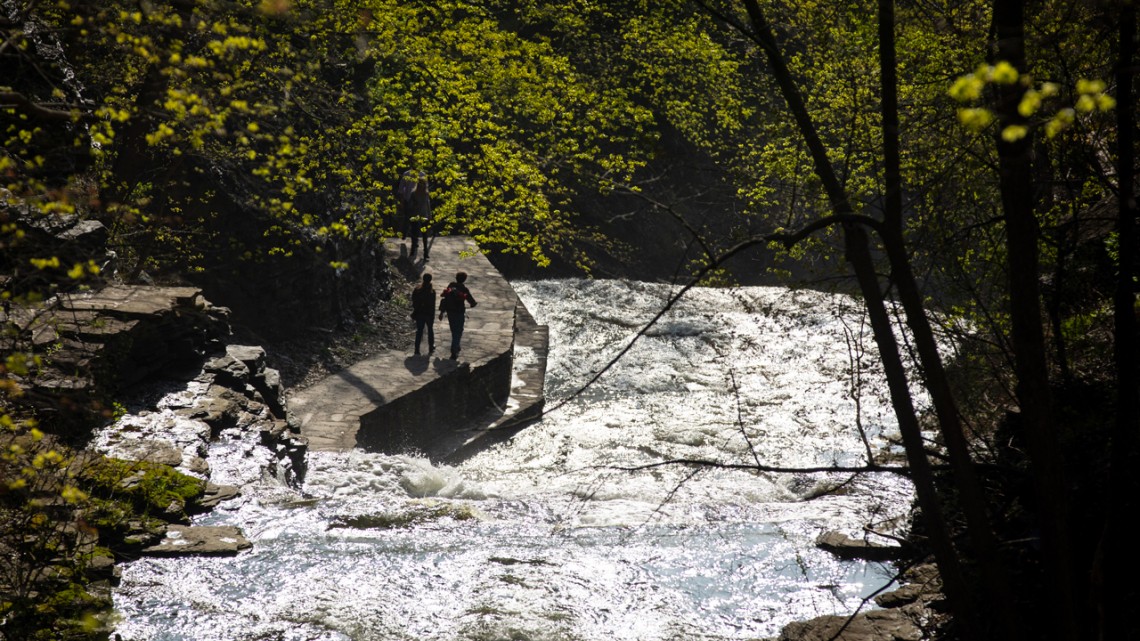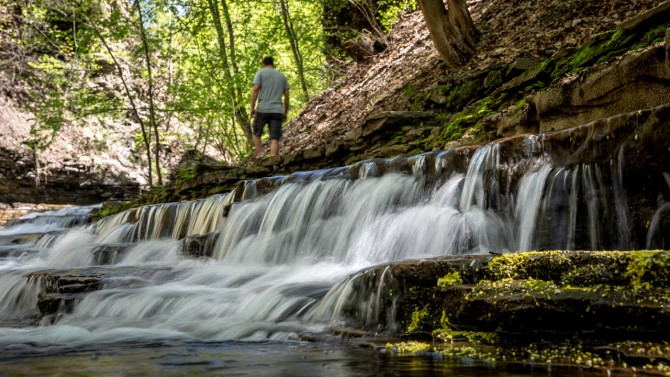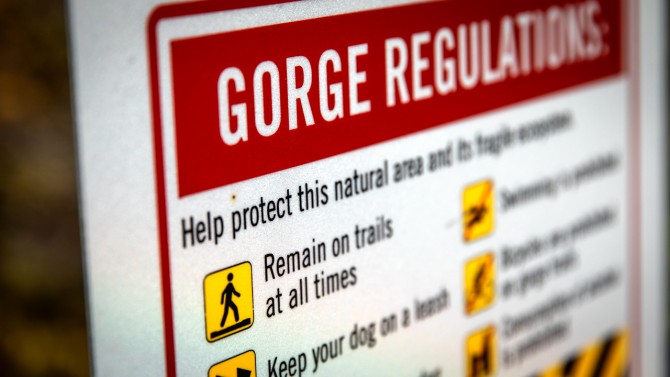
Community members walk through Cascadilla Gorge.
New signs highlight gorge dangers, delights
By Nancy Doolittle
Hiking in Cornell Botanic Gardens’ Natural Areas is good for your mental and physical well-being, but it is not a walk in the park.
Trails can be slippery when wet, while off-trail conditions can be downright treacherous. And the same geological processes that created the beauty of waterfalls, lakes and gorges also created hazards.
But resources abound – on Cornell’s Gorge Safety website, on signs along the Botanic Gardens’ trails and through the work of the gorge stewards – to help visitors safely explore and enjoy these natural areas. Most recently around Beebe Lake, new wayfinding signs have been installed – and additional orientation signs are coming this summer – to make Cornell’s vast campus and natural areas easier to navigate.
“We try to facilitate safe and responsible use of all of the gardens’ natural areas,” said Todd Bittner, natural areas director for the Cornell Botanic Gardens and chair of the university’s Gorge Safety Committee. That responsible use includes not damaging or detracting from the beauty of these areas as well as staying safe, Bittner said.
Four principles guide the collective work of the gorge safety committee, natural areas staff, and gorge stewards, he said:
- building awareness around the inherent dangers present in the gorges;
- maintaining and improving trails, staircases, railings, signage and fences;
- promoting safety by enforcing campus and gorge regulations; and
- highlighting alternative activities to unsafe use and behaviors.
The Nathaniel Rand ‘12 Memorial Gorge Safety Education Program – named in memory of a student who died in a gorge drowning accident in 2011 – furthers all of these goals, Bittner said. As part of this program, each year five to six student gorge stewards patrol the gorges, identifying unsafe practices and serving as ambassadors to help inform visitors of the ways they can safely appreciate and use the gorges.
Swimming not only is extremely dangerous and can lead to death, but also is strictly prohibited in the gorges at all times. Safe outdoor swimming options are available off campus.
The Gorge Stewards Program, established in 2012, is managed by Cornell Outdoor Education. Bittner said, “We know from data gathered from gorge stewards that the number of violations of all gorge regulations has dropped dramatically since the beginning of the Gorge Stewards Program, from more than 8% of all counted users found in violation in 2013 to less than 1% in 2018.”
But while gorge safety violations have decreased, one safety factor has not: Nearly every year, close to one-third of gorge stewards’ interactions with visitors are for giving directions. For that reason, in the fall of 2018 pedestrian wayfinding signs were installed at every trail and walkway intersection near Beebe Lake to better direct users to North Campus, the Arts and Ag Quads and Cornell Botanic Gardens. The project represents the first pedestrian implementation of the university’s signage and wayfinding master plan.
Last spring, to help users in an emergency or distress give first responders their exact location, red emergency locator signs were posted throughout the gorges near the regulation signs. Those locations are pinpointed on emergency response maps at Cornell University Police.
In addition, this summer three new orientation signs will be installed around Beebe Lake, with “You Are Here” map indicators, information about the natural and cultural history of the area, notable points of interest and activities that can be safely enjoyed.
To help educate first-year and transfer students during the heavy use period just before classes start, the gorge safety education program includes orientation hikes for new students – who are required to view the program’s gorge safety video – and programming for orientation leaders and residence advisers.
The video, a gorge safety brochure and more information on the gorges and natural area trails, including trail closings, can be found on the Gorge Safety website.
Media Contact
Get Cornell news delivered right to your inbox.
Subscribe

